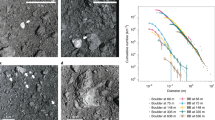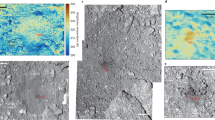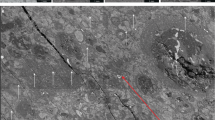Abstract
When rubble-pile asteroid 2008 TC3 impacted Earth on 7 October 2008, the recovered rock fragments indicated that such asteroids can contain exogenic material1,2. However, spacecraft missions to date have only observed exogenous contamination on large, monolithic asteroids that are impervious to collisional disruption3,4. Here, we report the presence of metre-scale exogenic boulders on the surface of near-Earth asteroid (101955) Bennu—the 0.5-km-diameter, rubble-pile target of the OSIRIS-REx mission5 that has been spectroscopically linked to the CM carbonaceous chondrite meteorites6. Hyperspectral data indicate that the exogenic boulders have the same distinctive pyroxene composition as the howardite–eucrite–diogenite (HED) meteorites that come from (4) Vesta, a 525-km-diameter asteroid that has undergone differentiation and extensive igneous processing7,8,9. Delivery scenarios include the infall of Vesta fragments directly onto Bennu or indirectly onto Bennu’s parent body, where the latter’s disruption created Bennu from a mixture of endogenous and exogenic debris. Our findings demonstrate that rubble-pile asteroids can preserve evidence of inter-asteroid mixing that took place at macroscopic scales well after planetesimal formation ended. Accordingly, the presence of HED-like material on the surface of Bennu provides previously unrecognized constraints on the collisional and dynamical evolution of the inner main belt.
This is a preview of subscription content, access via your institution
Access options
Access Nature and 54 other Nature Portfolio journals
Get Nature+, our best-value online-access subscription
$29.99 / 30 days
cancel any time
Subscribe to this journal
Receive 12 digital issues and online access to articles
$119.00 per year
only $9.92 per issue
Buy this article
- Purchase on Springer Link
- Instant access to full article PDF
Prices may be subject to local taxes which are calculated during checkout



Similar content being viewed by others
Data availability
The OCAMS (MapCam and PolyCam), OLA and OVIRS data that support the findings and plots within this paper are available from the Planetary Data System (PDS) at https://sbn.psi.edu/pds/resource/orex/ocams.html, https://sbn.psi.edu/pds/resource/orex/ola.html and https://sbn.psi.edu/pds/resource/orex/ovirs.html, respectively. Data are delivered to the PDS according to the schedule in the OSIRIS-REx Data Management Plan, available in the OSIRIS-REx mission bundle at https://sbnarchive.psi.edu/pds4/orex/orex.mission/document/. Data shown in Supplementary Figs. 7 and 8 were obtained from the Minor Planet Physical Properties Catalogue (MP3C, https://mp3c.oca.eu/) of the Observatoire de la Côte d’Azur.
Code availability
The collisional analysis reported here uses a custom code that is based on established methods described in refs. 53,54,55,56,57,58). The ISIS3 code used to generate the image processing data products is a customized version of code available from the US Geological Survey–Astrogeology Science Center: https://isis.astrogeology.usgs.gov/. The MGM code used to analyse OVIRS spectral data is available from RELAB at Brown University: http://www.planetary.brown.edu/mgm/.
References
Jenniskens, P. A. et al. The impact and recovery of asteroid 2008 TC3. Nature 458, 485–488 (2009).
Bischoff, A., Horstmann, M., Pack, A., Laubenstein, M. & Haberer, S. Asteroid 2008 TC3—Almahata Sitta: a spectacular breccia containing many different ureilitic and chondritic lithologies. Meteorit. Planet. Sci. 45, 1638–1656 (2010).
McCord, T. B. et al. Dark material on Vesta from the infall of carbonaceous volatile-rich material. Nature 491, 83–86 (2012).
Reddy, V. et al. Delivery of dark material to Vesta via carbonaceous chondritic impacts. Icarus 221, 554–559 (2012).
Lauretta, D. S. et al. OSIRIS-REx: sample return from asteroid (101955) Bennu. Space Sci. Rev. 212, 925–984 (2017).
Hamilton, V. E. et al. Evidence for widespread hydrated minerals on asteroid (101955) Bennu. Nat. Astron. 3, 332–340 (2019).
Consolmagno, G. J. & Drake, M. J. Composition and evolution of the eucrite parent body: evidence from rare earth elements. Geochim. Cosmochim. Acta 41, 1271–1282 (1977).
Binzel, R. P. & Xu, S. Chips off of asteroid 4 Vesta: evidence for the parent body of basaltic achondrite meteorites. Science 260, 186–191 (1993).
Russell, C. T. et al. Dawn at Vesta: testing the protoplanetary paradigm. Science 336, 684–686 (2012).
Rizk, B. et al. OCAMS: the OSIRIS-REx Camera Suite. Space Sci. Rev. 214, 26 (2018).
Lauretta, D. S. et al. The unexpected surface of asteroid (101955) Bennu. Nature 568, 55–60 (2019).
DellaGiustina, D. N. et al. Properties of rubble-pile asteroid (101955) Bennu from OSIRIS-REx imaging and thermal analysis. Nat. Astron. 3, 341–351 (2019).
Reuter, D. C. et al. The OSIRIS-REx Visible and Infrared Spectrometer (OVIRS): spectral maps of the asteroid Bennu. Space Sci. Rev. 214, 54 (2018).
Cloutis, E. A. & Gaffey, M. J. Pyroxene spectroscopy revisited: spectral‐compositional correlations and relationship to geothermometry. J. Geophys. Res. 96, 22809–22826 (1991).
Klima, R. L., Pieters, C. M. & Dyar, M. D. Characterization of the 1.2 μm M1 pyroxene band: extracting cooling history from near‐IR spectra of pyroxenes and pyroxene‐dominated rocks. Meteorit. Planet. Sci. 43, 1591–1604 (2008).
Sunshine, J. M., Pieters, C. M. & Pratt, S. F. Deconvolution of mineral absorption bands: an improved approach. J. Geophys. Res. 95, 6955–6966 (1990).
Sunshine, J. M. et al. High‐calcium pyroxene as an indicator of igneous differentiation in asteroids and meteorites. Meteorit. Planet. Sci. 39, 1343–1357 (2004).
Burbine, T. H. et al. Can formulas derived from pyroxenes and/or HEDs be used to determine the mineralogies of V‐type asteroids? J. Geophys. Res. 123, 1791–1803 (2018).
Brearley, A. J. & Jones, R. H. in Planetary Materials Vol. 36 (ed. Papike, J. J.) 3.001–3.398 (Mineralogical Society of America, 1998).
Cloutis, E. A. et al. Spectral reflectance properties of HED meteorites + CM2 carbonaceous chondrites: comparison to HED grain size and compositional variations and implications for the nature of low-albedo features on Asteroid 4 Vesta. Icarus 223, 850–877 (2013).
Le Corre, L. et al. How to characterize terrains on 4 Vesta using Dawn Framing Camera color bands? Icarus 216, 376–386 (2011).
Moskovitz, N. A. et al. A spectroscopic comparison of HED meteorites and V-type asteroids in the inner Main Belt. Icarus 208, 773–788 (2010).
Hardersen, P. S. et al. Basalt or not? Near-infrared spectra, surface mineralogical estimates, and meteorite analogs for 33 Vp-type asteroids. Astron. J. 156, 11 (2018).
Bottke, W. F. et al. In search of the source of asteroid (101955) Bennu: applications of the stochastic YORP model. Icarus 247, 191–217 (2015).
Campins, H. et al. The origin of asteroid 162173 (1999 JU3). Astron. J. 146, 26 (2013).
Walsh, K. J., Delbó, M., Bottke, W. F., Vokrouhlický, D. & Lauretta, D. S. Introducing the Eulalia and new Polana asteroid families: re-assessing primitive asteroid families in the inner Main Belt. Icarus 225, 283–297 (2013).
Avdellidou, C., Price, M. C., Delbo, M., Ioannidis, P. & Cole, M. J. Survival of the impactor during hypervelocity collisions–I. An analogue for low porosity targets. Mon. Not. R. Astron. Soc. 456, 2957–2965 (2016).
Avdellidou, C., Price, M. C., Delbo, M. & Cole, M. J. Survival of the impactor during hypervelocity collisions–II. An analogue for high-porosity targets. Mon. Not. R. Astron. Soc. 464, 734–738 (2017).
Bottke, W. F. Jr et al. Linking the collisional history of the main asteroid belt to its dynamical excitation and depletion. Icarus 179, 63–94 (2005).
Burbine, T. H. et al. in Asteroids III (eds Bottke, W. F. et al.) 653–668 (University of Arizona Press, 2002).
Schenk, P. et al. The geologically recent giant impact basins at Vesta’s south pole. Science 336, 694–697 (2012).
Spoto, F., Milani, A. & Knežević, Z. Asteroid family ages. Icarus 257, 257–289 (2015).
Bischoff, A., Edward, R. D. S., Metzler, K. & Goodrich, C. A. in Meteorites and the Early Solar System II (eds Lauretta, D. S. & McSween, H. Y. Jr) 679–712 (University of Arizona Press, 2006).
Walsh, K. J. et al. Craters, boulders and regolith of (101955) Bennu indicative of an old and dynamic surface. Nat. Geosci. 12, 242–246 (2019).
Hirata, N. & Ishiguro, M. Properties and possible origin of black boulders on the asteroid Itokawa. In 42nd Lunar and Planetary Science Conference Abstract no. 1821 (Lunar and Planetary Institute, 2011).
De León, J. et al. Expected spectral characteristics of (101955) Bennu and (162173) Ryugu, targets of the OSIRIS-REx and Hayabusa2 missions. Icarus 313, 25–37 (2018).
Sugita, S. et al. The geomorphology, color, and thermal properties of Ryugu: implications for parent-body processes. Science 364, eaaw0422 (2019).
Tatsumi, E. et al. Bright boulders suggest a collision between an S-type asteroid and Ryugu’s parent body. Nat. Astron. https://doi.org/10.1038/s41550-020-1179-z (2020).
Ebert, S. et al. Accretion of differentiated achondritic and aqueously altered chondritic materials in the early solar system—significance of an igneous fragment in the CM chondrite NWA 12651. Meteorit. Planet. Sci. 55, 2985–2995 (2019).
Kerraouch, I. et al. A light, chondritic xenolith in the Murchison (CM) chondrite— formation by fluid-assisted percolation during metasomatism? Geochemistry 79, 125518 (2019).
Zolensky, M. E. et al. Mineralogy of carbonaceous chondrite clasts in HED achondrites and the Moon. Meteorit. Planet. Sci. 31, 518–537 (1996).
Golish, D. R. et al. Ground and in-flight calibration of the OSIRIS-REx Camera Suite. Space Sci. Rev. 216, 12 (2020).
Golish, D. R. et al. Disk-resolved photometric modeling and properties of asteroid (101955) Bennu. Icarus https://doi.org/10.1016/j.icarus.2020.113724 (2020).
Barnouin, O. S. et al. Shape of (101955) Bennu indicative of a rubble pile with internal stiffness. Nat. Geosci. 12, 247–252 (2019).
DellaGiustina, D. N. et al. Overcoming the challenges associated with image‐based mapping of small bodies in preparation for the OSIRIS‐REx mission to (101955) Bennu. Earth Space Sci. 5, 929–949 (2018).
Daly, M. G. et al. The OSIRIS-REx Laser Altimeter (OLA) investigation and instrument. Space Sci. Rev. 212, 899–924 (2017).
Christensen, P. R. et al. The OSIRIS-REx Thermal Emission Spectrometer (OTES) instrument. Space Sci. Rev. 214, 87 (2018).
Simon, A. A. et al. OSIRIS‐REx visible and near‐infrared observations of the Moon. Geophys. Res. Lett. 46, 6322–6326 (2019).
Sunshine, J. M. & Pieters, C. M. Estimating modal abundances from the spectra of natural and laboratory pyroxene mixtures using the modified Gaussian model. J. Geophys. Res. 98, 9075–9087 (1993).
Reddy, V. et al. in Asteroids IV (eds Michel, P. et al.) 43–63 (University of Arizona Press, 2015).
Pieters, C. M. & Hiroi, T. RELAB (Reflectance Experiment Laboratory): a NASA multiuser spectroscopy facility. In 35th Lunar and Planetary Science Conference Abstract no. 1720 (Lunar and Planetary Institute, 2004).
Walsh, K. J. et al. Likelihood for rubble-pile near-Earth asteroids to be 1st or Nth generation: focus on Bennu and Ryugu. In 51st Lunar and Planetary Science Conference Abstract no. 2253 (Lunar and Planetary Institute, 2020).
Bottke, W. F., Nolan, M. C., Greenberg, R. & Kolvoord, R. A. Velocity distributions among colliding asteroids. Icarus 107, 255–268 (1994).
Avdellidou, C., Delbo, M. & Fienga, A. Exogenous origin of hydration on asteroid (16) Psyche: the role of hydrated asteroid families. Mon. Not. R. Astron. Soc. 475, 3419–3428 (2018).
Briani, G., Morbidelli, A., Gounelle, M. & Nesvorny, D. Evidence for an asteroid–comet continuum from simulations of carbonaceous microxenolith dynamical evolution. Meteorit. Planet. Sci. 46, 1863–1877 (2011).
Gayon-Markt, J. et al. On the origin of the Almahata Sitta meteorite and 2008 TC3 asteroid. Mon. Not. R. Astron. Soc. 424, 508–518 (2012).
Turrini, D. et al. The contamination of the surface of Vesta by impacts and the delivery of the dark material. Icarus 240, 86–102 (2014).
Turrini, D. et al. Olivine on Vesta as exogenous contaminants brought by impacts: constraints from modeling Vesta’s collisional history and from impact simulations. Icarus 280, 328–339 (2016).
Nesvorný, D., Miroslav, B. & Valerio C. in Asteroids IV (eds Michel, P. et al.) 297–321 (University of Arizona Press, 2015).
Daly, R. T. & Schultz, P. H. Delivering a projectile component to the vestan regolith. Icarus 264, 9–19 (2016).
Daly, R. T. & Schultz, P. H. The delivery of water by impacts from planetary accretion to present. Sci. Adv. 4, eaar2632 (2018).
O’Brien, D. P. & Sykes, M. V. The origin and evolution of the asteroid belt—implications for Vesta and Ceres. Space Sci. Rev. 163, 41 (2011).
Housen, K. R., Sweet, W. J. & Holsapple, K. A. Impacts into porous asteroids. Icarus 300, 72–96 (2018).
Avdellidou, C. et al. Very weak carbonaceous asteroid simulants I: mechanical properties and response to hypervelocity impacts. Icarus 341, 113648 (2020).
Bottke, W. F. et al. Interpreting the cratering histories of Bennu, Ryugu, and other spacecraft-explored asteroids. Astron. J. https://doi.org/10.3847/1538-3881/ab88d3 (2020).
Holsapple, K. Theory and Equations for Craters from Impacts and Explosions (St. Louis, MO, Washington University, 2003).
Jutzi, M., Michel, P., Benz, W. & Richardson, D. C. Fragment properties at the catastrophic disruption threshold: the effect of the parent body’s internal structure. Icarus 207, 54–65 (2010).
Acknowledgements
This material is based upon work supported by NASA under contract NNM10AA11C issued through the New Frontiers Program. The work of C.A. was supported by the French National Research Agency under the project ‘Investissements d’Avenir’ UCAJEDI ANR-15-IDEX-01. C.A. and M.D. would like to acknowledge the French space agency CNES and support from the ANR ‘ORIGINS’ (ANR-18-CE31-0014). M.A.B. also acknowledges support from CNES the French space agency. G.P. acknowledges support from the INAF-Astrophysical Observatory of Arcetri, which is supported by Italian Space Agency agreement no. 2017-37-H.0. E.T. was supported by the JSPS core-to-core program International Planetary Network. The OLA instrument and funding for M.G.D., M.M.A.A., L.P. and J.S. is provided by the Canadian Space Agency. This research uses spectra acquired at the NASA RELAB facility at Brown University. This work also makes use of data provided by the Minor Planet Physical Properties Catalogue (MP3C) of the Observatoire de la Côte d’Azur. We thank the entire OSIRIS-REx team for making the encounter with Bennu possible.
Author information
Authors and Affiliations
Contributions
D.N.D. leads the OSIRIS-REx image processing working group (IPWG) that discovered and characterized exogenic boulders on Bennu using OCAMS data. H.H.K. led the OVIRS spectral analysis that linked the exogenic boulders on Bennu to the HED meteorites. D.R.G., M.P., H.C., L.L.C., N.P., J.L.R.G., E.T., J.d.L., J.L., S.F., B.R. and M.C.N. conducted the image processing of OCAMS data. A.A.S., V.E.H., M.A.B., G.P., B.E.C., E.S.H., R.P.B. and D.C.R. conducted the spectral characterization and compositional analysis using OVIRS data. W.F.B., C.A., M.D. and K.J.W. conducted the collisional modelling. R.-L.B., R.T.D., E.R.J., T.J.M. and H.C.C. conducted an assessment of the geologic setting. M.G.D., M.M.A.A., L.P., J.S. and O.S.B. produced the OLA digital terrain models. D.S.L. is the principal investigator and leads the OSIRIS-REx mission.
Corresponding authors
Ethics declarations
Competing interests
The authors declare no competing interests.
Additional information
Publisher’s note Springer Nature remains neutral with regard to jurisdictional claims in published maps and institutional affiliations.
Extended data
Extended Data Fig. 1 Comparing high- and low-resolution OVIRS spectra of site 6.
a, The lower-resolution spectrum (magenta) of site 6 shown in the main-text as compared to three higher-resolution pyroxene spectra obtained of site 6 (teal) during a lower altitude (~1.4 km) regional flyby of Bennu by the OSIRIS-REx spacecraft. The lower-resolution spectrum (magenta) has been ratioed by Bennu’s global average spectrum to bring out the subtle pyroxene absorption features near 1 and 2 μm, whereas the high-resolution spectra do not require any ratioing to observe these absorption features. b, The band I and II centers (1 and 2 μm) calculated for the pyroxene absorption features plotted against each other, for the lower-resolution (ratioed, magenta) and higher-resolution (unratioed, teal) spectra of site 6. The spectral ratioing does not affect the band centers obtained beyond the uncertainty assigned by the fitting procedure. c, HCP% versus the ratio of the LCP to the HCP band strengths for the lower-resolution (ratioed, magenta) and higher-resolution (unratioed, teal) spectra of site 6, which again shows that the ratioing procedure does not affect the results obtained by applying the MGM to these spectra.
Supplementary information
Supplementary Information
Supplementary Figs. 1–9 and Tables 1–4.
Rights and permissions
About this article
Cite this article
DellaGiustina, D.N., Kaplan, H.H., Simon, A.A. et al. Exogenic basalt on asteroid (101955) Bennu. Nat Astron 5, 31–38 (2021). https://doi.org/10.1038/s41550-020-1195-z
Received:
Accepted:
Published:
Issue Date:
DOI: https://doi.org/10.1038/s41550-020-1195-z
This article is cited by
-
Cosmic dust fertilization of glacial prebiotic chemistry on early Earth
Nature Astronomy (2024)
-
Mid-infrared emissivity of partially dehydrated asteroid (162173) Ryugu shows strong signs of aqueous alteration
Nature Communications (2022)
-
Cross-Instrument Comparison of MapCam and OVIRS on OSIRIS-REx
Space Science Reviews (2022)
-
Hydrodynamic instability at impact interfaces and planetary implications
Nature Communications (2021)
-
Exogenous copper sulfide in returned asteroid Itokawa regolith grains are likely relicts of prior impacting body
Communications Earth & Environment (2021)



